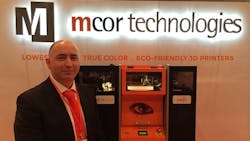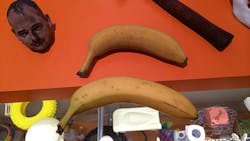Over the last couple of years, the 3-D printing industry has become suddenly crowded with startups, sellers and mega-sized corporations pitching capabilities ranging from cheap monochrome plastic toys to exotic metal functional parts. The whole of the 3-D printing revolution, it seems, falls somewhere along that material continuum.
But one company stands outside.
Mcor Technologies' printers ignore that continuum, offering printers that remain outside the trends and big business ramp up of proprietary materials.
Instead, it prints in paper. Ordinary, everyday reams of office paper, stacked and printed in full, high-res color and cut into intricate 3-D shapes.
That technique remains one of the most original and potentially disruptive systems in an industry defined by disruption. And if it isn't, it is at least one of the wackiest points of innovation since Scott Crump's FDM experiments.
We recently caught up with Mcor's co-founder and CEO, Conor MacCormack, to find out what makes this technology work and where it is going next.
Q: So, why paper?
A: My brother and I had a lot of exposure to computer aided design and rapid prototyping within some big organizations. About 10 years ago, we took a look at the industry to see what we could do differently.
We looked at speed, if we could make a machine that was really, really fast. But we felt that people were doing that already.
Then we thought about doing different strength materials, people were doing that already.
But nobody seemed to be going after the low cost.
Printers were at the time, 80,000, 90,000, 100,000 euros. And they were coming down a little bit in price, but the running costs were like through the roof. Since then, they have just kept on going.
We felt, very strongly, that the reason why the industry was only selling 2,000 or 3,000 units per year globally was because the running costs were so high. And we felt that if we could build a machine that had zero running costs, we could make an impact.
We wanted to be completely opposite everybody else. We really wanted to upset the status quo and build a machine that people wouldn't have to worry about hitting print anymore.
So we said, let's build a machine that is almost free to run, plus one that used one of the most accessible material that anybody can get their hands on. Materials that they wouldn't have to wait for stock to come in. What could anybody get easily? Reams of paper.
So we said, let's start with paper.
Engineering Challenge
Q: The 3-D printing industry seems pretty fixed on a handful of technologies and materials, most of it falling somewhere between plastics and metals. Except you. How did you even come up with this?
A: From the very first idea, we wanted to be green, ecofriendly.
And not just because we are eco-warriors or anything like that, but because we could see in time machines like this being in schools, being in classrooms.
From my exposures I had before with plastics and powder technologies, I knew that wasn't really feasible.
So I said, let's use water-based adhesives, regular paper and just go from there.
We thought that would be the easy bit. Stick together layers of paper. People in China have probably been doing that for a couple thousand years.
Actually it turns out to be a very complicated challenge because water-based adhesives in paper, water and paper don't really like each other.
So the adhesive that we use is very similar to a water-based adhesive that you'd use in an art project for kids. But the problem with that is it is very viscous. It is 1500 times thicker than water.
The good of that is it's very green, the bad is that we couldn't get any way to jet it.
So we spent the first couple of years working on that technique to very accurately and very precisely, deploy a small amount of adhesive anywhere we want on the page and the seal the whole system off without the adhesive drying up and all that.
Fast forward a little bit, and in January 2013 we started to sell our color machine, the Mcor IRIS, which is the full color variance, names after Greek god of the rainbow.
To do that, we utilized a 2-D print technology.
Effectively, we said, 'What is the quickest way we can get to color printing? Let's leverage off the 2-D printing industry. There are already these 2-D printer manufacturers doing very high resolution 2-D images. Let's try to make that into 3-D.'
One of the hurdles that we needed to overcome there was ink has been designed to sit on the top surface of the paper. HP and all of these other companies have been making inks sit on the top surface, but if you have regular ink and you put ink on that sheet and you cut that sheet, the edge of that cut is all white. The ink does not protrude.
So we reverse engineered the ink. We made the ink actually print in 3-D, in each layer it actually prints downward. Anywhere there is a vertical face, you need to put the color on. The inside, if you don't need the color, if you don't see it, it's white. So it's very economic on the amount of ink you are putting down.
Q: What is it that printed paper can do that plastics can't?
A: We compete against all of the big guys head-to-head. 3-D Systems and the Stratasys, all the rest.
There are certain things they can do that we can't, certain things that we can do that they can't. The industry is like that at the moment, there is no one machine that can do everything yet.
We have very clear areas where we are very strong. The first is running cost.
Because we are using paper and water based adhesives, you can print an object using multicolored paper instead of color ink. We call this ply color. Printing like that, you get 30 times cheaper than plastic.
For true color – and here we're talking about a bit mat image where you take like a photograph – you need to be able to change instantly from one color to the next. Some of our full 3-D printer color, we do about 5 times cheaper than plastic machines for running costs.
The second thing in the color itself.
Because we use paper and ink, paper and ink, ink was designed to work with paper. We're utilizing on the very high resolution on the 2-D printer, we can get a very high-res image into the 2-D paper and just making that 3-D.
So not only is the resolution very high, but the color fidelity between what you get on the screen and what you get on the printed object is very close.
We have a very good color match.
The third thing is it's green; it's an ecofriendly solution.
You can take these products and throw it into your paper recycle bin. Or with any of the base material. You can just throw it out.
That really is not enough for people to buy the machine. People aren't just going to buy it on the eco credentials, but it is a nice thing to have.
And when you're dealing with the universities, a good portion of the tender could come down to the eco-friendliness or the sustainability of the solution.
Users & the Future
Q: Who is using this?
A: The product designers for the early stage of design review. We would have architects using it. We have people using it for GIS – for geographical information systems, mapping. People are printing out big cities, big towns, pipe layouts.
We have people using it in the packaging industry because it's actually very easy for us to make flexible hinges because all you need to make that a couple layers of thick and then build it flat.
For the packaging industry, they can put the high-res decal on a foldable object.
If you want to get full color flexible parts, the only machine is the IRIS.
We have people who are using it for tooling.
People would usually discount what we do, thinking it's only for prototyping and design, but there are people who are using it for vacuum forming and for light sheet metal pressing.
You can run over these products in your car. In compression, paper is extremely strong. If the loading direction is right, the parts can be really robust.
People are using it for light sheet metal pressing and that kind of idea for tooling.
That's kind of the range.
Q: What's next? Are you staying in the professional environment?
A: It's really interesting, actually. When we were at the CES show in January, we got to talking to people, consumers, and for the first time, everybody realized collectively that even though the price point of our machines is not for the consumer, the output of the machine is what they want. They want color. They want high-resolution color at a low price point.
So we're preparing products for producing parts for the consumer, but they can't buy the machine.
So us as the company, we are developing ways to let consumers get access to high quality stuff in retail stores, uploading images and content and then in the backroom, printing it on an Mcor device. Very similar to the 2-D printing analogy for photographs.
Until printers got good enough at home to print your photographs, everybody went to the photoshop. We think that we are going to get access to the consumer via high-end retail stores.
That again will seed the market for us.
And this is all coming from the consumer up, by the way. And that is really exciting.
Consumers are coming into these stores and saying, do you have a 3-D printer, do you have a 3-D printer? So it's been driven from the ground swell.
Rather than us telling these retailers that they should really have a machine in there, they're saying, I know, I know, can you help us?
There's a big future in that for, I think, everyone in this industry.
Check out IW's complete "Take 5" series, a regular section featuring interviews with top executives.






